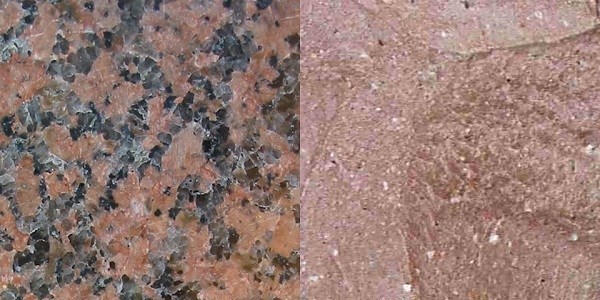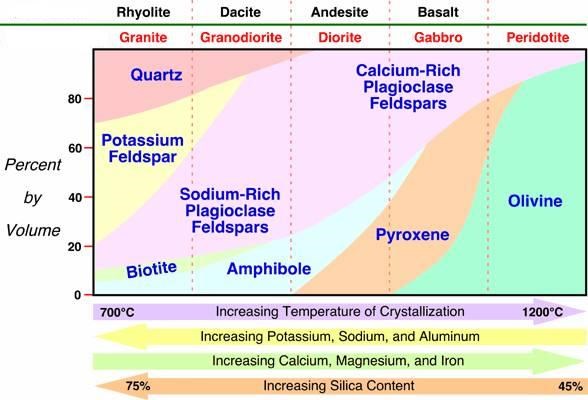
At the listed coordinates you will find bust of Maksimilijan Vrhovac. He was the the bishop of Zagreb from 1787 to 1827. For this EarthCache we are interested for the plinth of this bust. The plinth of this bust represents a nice specimen of igneous rock.
Igneous Rocks
Igneous rocks are formed by cooling of hot magma or lava and by its solidification. Although both magma and lava are essentially molten rock, the magma is molten rock while it is still below the surface and lava is molten rock on the surface of planet usually expelled by a volcano during an eruption. If the rock is formed from magma it is also called plutonic and if it is formed from lava it is called volcanic. The term “plutonic” came from the name of classical god of the underworld - Pluto, and the term “volcanic” came from the fact that the rock is formed from lava erupted from a volcano.
Igneous Rocks
 Source: Wikipedia
Source: Wikipedia
Plutonic rocks are also called intrusive rocks. That means that magma is slowly pushed up from the mantle within the earth and it intrudes by force into any cracks or spaces it can find. On the other hand, volcanic rocks are also called extrusive rocks because they are formed when hot magma extrudes onto the surface of planet as lava. The process of cooling of hot magma deep below surface of planet lasts much longer than cooling of hot lava on the surface of planet. Since it lasts longer, the larger crystals can grow during the process of solidification of intrusive rocks when compared to extrusive rocks.
Crystal Size
During the process of cooling and solidification of magma or lava, the process of crystallization or formation of crystals might or might not happen. So, that means that there are igneous rocks with crystals and igneous rocks without crystals. Those igneous rocks that are formed with crystals can be divided into those that have crystals large enough to be seen by the naked eye (they are also called phaneritic rocks), and those that have crystals too small to be seen by the naked eye (they are also called aphanitic rocks). Phaneritic rocks are also intrusive rocks, because they have more time to develop larger crystals during cooling of magma deep below surface of planet. Aphanitic rocks are also extrusive rocks because lava cools on surface of the planet and it happens much faster than below surface.
Phaneritic vs. Aphanitic Rocks
 Source: geologycafe.com
Source: geologycafe.com
Crystals in igneous rocks are seen in the form of grains of different colors and different sizes. Regarding their size, grains can be: (1) fine-grained (diameter of the grains is smaller than 1 millimeter), (2) medium-grained (diameter of the grains is between 1 and 5 millimeters), and (3) coarse-grained (diameter of the grains is larger than 5 millimeters). Intrusive or plutonic rocks usually have larger crystals because the process of cooling and solidification lasts much longer below the surface of planet. So, they are usually coarse-grained. Extrusive or volcanic rocks usually have smaller crystals because the process of cooling and solidification lasts much shorter on the surface of planet. So, they are usually fine-grained.
Mineral Composition
Igneous rocks can be categorized according to their mineral composition into two groups: mafic and felsic. Mafic minerals are dark in color, and common rock-forming mafic minerals include olivine, pyroxene, amphibole, and biotite. These minerals are silicate minerals that are rich in magnesium and iron. The term “mafic” is derived from using the “ma-“ from “magnesium” and the “-fic” from the “ferric”. Felsic minerals are light in color, and common rock-forming minerals include feldspar and quartz. Felsic minerals are also silicate minerals but they are rich in silicon, oxygen, aluminium, sodium, and potassium. The term “felsic” is derived from using the “fel-“ from “feldspar” and “-sic” from “silica”.
Mineral Composition of Igneous Rocks
 Source: Department of Geological Sciences, East Carolina University (www.ecu.edu/geology)
Source: Department of Geological Sciences, East Carolina University (www.ecu.edu/geology)
Igneous Rock Identification
Two main properties that are used for identification of igneous rocks are mineral composition and grain size. When you combine those two properties you can identify igneous rocks according to the key presented in the following table.
Igneous Rock Identification Key

So, you can identify igneous rock by identifying its color (mineral composition) and by determining its texture (grain size). Once this is done the rock name is easily determined. Note that identification key presented here is somewhat simplified as it does not include all mineral composition possibilities and all texture possibilities, but it will help with the identification of rock on the EarthCache location.
Logging Tasks
To log this EarthCache answer the following questions:
1. Describe the color and the texture of rock that you find at the EarthCache location.
2. Observe the grains of crystals within this rock. Is this rock ...
2a. ... phaneritic rock or aphanitic rock? Why?
2b. ... fine-grained, medium-grained or coarse-grained rock? Why?
2c. ... formed deep below the surface of planet or on the surface of planet? Why?
2d. ... formed from magma or from lava? Why?
3. Observe the color of this rock. Is this mafic or felsic rock? Why?
4. Based on your observations, identify the name of this rock. Explain.
Send your answers through my profile at geocaching.com (through e-mail or message center) and NOT in a log. You don't have to wait for me to approve your answers. Once you send your answers feel free to log this EarthCache as found. If there are problems with your answers, I will contact you.
Sources
1. Alecia M. Spooner, Geology for Dummies, Hoboken: Wiley Publishing, Inc., 2011.
2. Monica Price and Kevin Walsh, Rocks and Minerals, London: Dorling Kindersley, 2005.
3. Geology.com
4. Geology.About.com
5. Wikipedia.org

Na izlistanim koordinatama pronaći ćete bistu Maksimilijana Vrhovca. On je bio zagrebački biskup od 1787. do 1827. godine. Za potrebe ovog EarthCachea zanima nas postolje biste. Postolje je napravljeno od lijepog primjerka magmatske stijene.
Magmatske stijene
Magmatske stijene nastaju hlađenjem magme ili lave i njihovim skrutnjavanjem. Iako su i magma i lava zapravo rastaljene stijene, magma je rastaljena stijena koja se još nalazi ispod površine planeta, dok lava predstavlja rastaljenu stijenu koja se nalazi na površini planeta i koja je najčešće izbačena iz unutrašnjosti planeta erupcijom vulkana. Ako je stijena nastala od magme tada se naziva plutonska stijena, a ako je nastala od lave tada se naziva vulkanska stijena. Termin “plutonski” je došao od imena rimskog boga podzemlja – Plutona. Termin “vulkanski” se koristi zbog činjenice da je ta vrsta stijena nastala od lave koja je izbačena vulkanskom erupcijom.
Magmatske stijene
 Izvor: Wikipedia
Izvor: Wikipedia
Plutonske stijene se još nazivaju i intruzivne stijene. To znači da magma polagano pritišće prema gore iz zemljinog plašta i prodire silom u sve pukotine i slobodan prostor koji joj se nađe na putu. S druge strane, vulkanske stijene se još nazivaju i ekstruzivne stijene zato što nastaju kada magma izbije na površinu planeta u vidu lave. Proces hlađenja magme duboko ispod površine planeta traje puno duže od hlađenja lave na površini planeta. S obzirom da proces traje duže, veći kristali se formiraju tijekom skrutnjavanja intruzivnih stijena u odnosu na ekstruzivne stijene.
Veličina kristala
Tijekom procesa hlađenja i skrutnjavanja magme ili lave može, ali i ne mora doći do procesa kristalizacije, tj. do formiranja kristala može, ali i ne mora doći. To znači da postoje magmatske stijene s kristalima i magmatske stijene bez kristala. Magmatske stijene koje su formirane s kristalima mogu se podijeliti na stijene koje imaju kristale koji su dovoljno veliki da ih se može vidjeti golim okom i one se nazivaju faneritične stijene, te na stijene kod kojih se kristali ne mogu vidjeti golim okom i one se nazivaju afanitične stijene. Faneritične stijene su ujedno i intruzivne stijene jer su imale dovoljno vremena za razvoj velikih kristala tijekom hlađenja magme duboko ispod površine planeta. Afanitične stijene su ujedno i ekstruzivne stijene jer se lava hladi na površini planeta i taj proces se događa puno brže nego ispod površine planeta.
Faneritične vs. afanitične stijene
 Izvor: geologycafe.com
Izvor: geologycafe.com
Kristali u magmatskim stijenama su vidljivi u obliku zrna različitih boja i veličina. S obzirom na njihovu veličinu, zrna mogu biti: (1) fino-zrnata (promjer zrna je manji od 1 mm), (2) srednje-zrnata (promjer zrna je između 1 i 5 mm), i (3) krupno-zrnata (promjer zrna je veći od 5 mm). Intruzivne ili plutonske stijene uobičajeno imaju veće kristale zato što process njihovog hlađenja i skrutnjavanja traje duže. Stoga su ove stijene najčešće krupno-zrnate. Ekstruzivne ili vulkanske stijene uobičajeno imaju manje kristale zato što process njihovog hlađenja i skrutnjavanja traje puno kraće. Stoga su ove stijene najčešće fino-zrnate.
Mineralni sastav
Magmatske stijene se mogu kategorizirati prema njihovom minerološkom sastavu u dvije grupe: mafične i felsične stijene. Mafični minerali su tamne boje, a česti minerali u mafičnim stijenama su olivin, piroksen, amfibol i biotit. Ovi minerali su silikatni minerali koji su bogati magnezijem i željezom. Termin "mafic" je dobiven kombinacijom "ma-" za magnezij i "-fic" za "ferric". Felsični minerali su svijetle boje, a česti minerali u felsičnim stijenama su feldspat i kvarc. Felsični minerali su također silikatni minerali ali su oni bogati silicijem, kisikom, aluminijem, natrijem i kalijem. Termin "felsic" je dobiven kombinacijom "fel-" za "feldspat" i "-sic" za "silica".
Mineralni sastav magmatskih stijena
 Izvor: Department of Geological Sciences, East Carolina University (www.ecu.edu/geology)
Izvor: Department of Geological Sciences, East Carolina University (www.ecu.edu/geology)
Identifikacija magmatskih stijena
Dva glavna obilježja koja se koriste za identifikaciju magmatskih stijena su mineralni sastav i veličina zrna kristala. Kada se kombiniraju ova dva obilježja moguće je identificirati magmatske stijene prema ključu prikazanom u sljedećoj tablici.
Ključ za identificiranje magmatskih stijena

Dakle, magmatsku stijenu je moguće identificirati na način da se identificira boja stijene (mineralni sastav) i odredi tekstura stijene (veličina zrna kristala). Kada se odrede ova dva obilježja, tada je jednostavno odrediti o kojoj se stijeni radi. Ključ za identifikaciju koji je ovdje prikazan je pojednostavljen i ne sadrži sve moguće slučajeve mineralnog sastava i teksture, ali može poslužiti u identifikaciji stijene na lokaciji EarthCachea.
Zadaci za logiranje
Kako biste logirali ovaj EarthCache odgovorite na sljedeća pitanja:
1. Opišite boju i teksturu kamena koji se nalazi na lokaciji EarthCachea.
2. Promotrite zrna kristala u ovom kamenu. Je li ovaj kamen ...
2a. ... faneritičan ili afanitičan? Zašto?
2b. ... fino-zrnat, srednje-zrnat ili krupno-zrnat? Zašto?
2c. ... formiran duboko ispod površine planeta ili na površini planeta? Zašto?
2d. ... formiran od magme ili od lave? Zašto?
3. Promotrite boju ovog kamena. Je li ovaj kamen mafičan ili felsičan? Zašto?
4. Na temelju Vašeg promatranja, identificirajte o kojoj se stijeni ovdje radi. Objasnite.
Odgovore pošaljite preko mog profila na geocaching.com, a NE u Vašem logu! Ne morate čekati na moje potvrdjivanje Vaših odgovora. Jednom kada pošaljete Vaše odgovore slobodno logirajte pronalazak ovog EarthCachea. Ako Vaši odgovori budu pogrešni ja ću kontaktirati Vas.
Izvori
1. Alecia M. Spooner, Geology for Dummies, Hoboken: Wiley Publishing, Inc., 2011.
2. Monica Price and Kevin Walsh, Rocks and Minerals, London: Dorling Kindersley, 2005.
3. Geology.com
4. Geology.About.com
5. Wikipedia.org